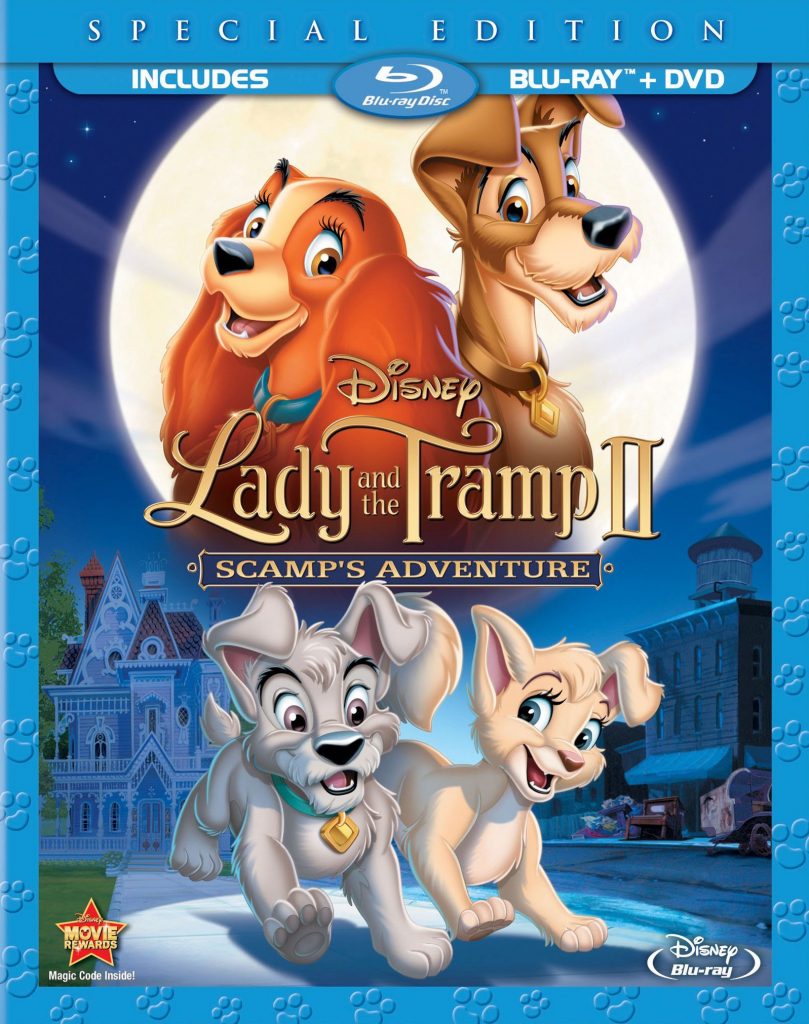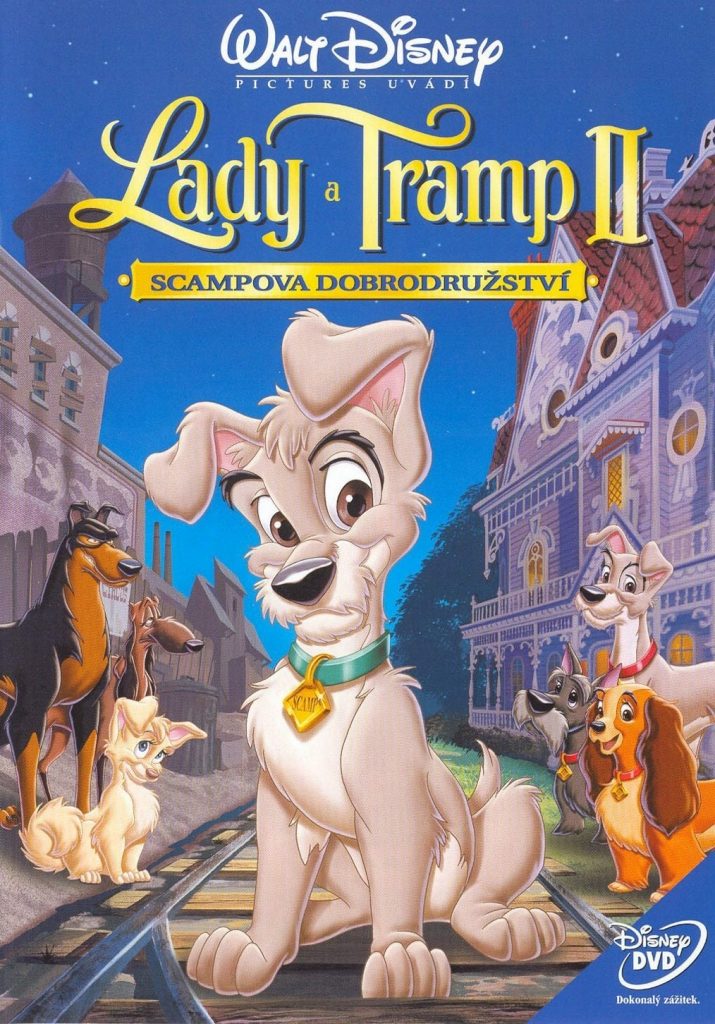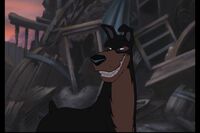In this sequel to Lady and the Tramp, the story of Lady’s and Tramp’s rambunctious young pup, Scamp is followed. Scamp desperately wants to be free to run, play, chew, and to not follow the strict rules imposed upon him through family life. In search of the adventure he wants, Scamp runs away from home leaving behind a worried dog and human family that desperately miss him and search for him as good pet owners and parents would. In his time on the streets, Scamp meets the lovely Angel, who is essential to teaching Scamp how to survive on the streets and the true importance of family. He also joins a group of junkyard dogs lead by Buster. Buster’s tests for Scamp to become a real junkyard dog are really a way to get revenge on Tramp, who used to be Buster’s street pal before he left for a life as a house dog in the first movie. Through the tests, Scamp realizes that what he really wants was right at home all along and showed him the true importance of family.
Disney movies are well known for being family movies. Lady and the Tramp II keeps the theme of family as a main focus of the movie by using dogs as a symbol of a very real human issue. The very beginning of the movie opens with a scene of the whole family, dogs included, and the song, “Welcome Home” which tells a tale of being welcome to the community; this effectively invites the viewer to join the story which is about to unfold, as well as setting the theme for the whole movie-independence.
Scamp wants to gain his freedom from his family which is shown in the beginning as stifling to his natural puppy exuberance and teen-like rebelling of the rules. While this is a way that humans would interpret a child’s need to run away, it may not be the case with puppies. They might run just to run and then get lost or they may chase a creature such as a rabbit, which does not always have a happy or meaningful ending. By making Scamp search for independence, we are putting human qualities in the animal in order to show a story that is more relatable to for children and families. Jonathan Burt describes the positive attributes of anthropomorphism in his book, Animals in Film, as a shared “understanding of human and animal,”1. There has to be a level of understanding between animals and humans for the telling of a human tale through the use of dogs to work. If there was no understanding, the story would be useless and meaningless.
The other reason that the anthropomorphism works for dogs in this tale is that they are pets. In part three of Thinking With Animals by Greg Mitman, an essay by James Serpell says that in order for humans to better care for their pets, they have “interpreted and evaluated the various behavioral signals… from their pets as if they were coming from fellow human beings,”2. By having already anthropomorphisized dogs, it makes it easier to transfer a human story to them in film and create an emotional connection. Due to this, children viewing the movie can see Scamp as a puppy wanting to play, as children do, but also feel a sense of kinship with him in wanting to be on their own and not obeying the rules their parents provide. Parents can also relate to Scamp in remembrance of their own rebellious days, but also to Lady and Tramp as trying to keep a rambunctious child under wraps or even as humans trying to raise a puppy with all the work they take.
The theme of family continues throughout the movie as Scamp wrestles between trying to find a place to belong on the streets and missing not only the comforts and safety of home, but his family. Scamps longing for his family grows through the mismatched junkyard dog gang that Scamp tries to join for a place to belong on the streets. While chained up outside, Scamp’s introduction to the junkyard dogs is watching them run freely and play with the dog catcher’s hat. This is the epitome of what Scamp wants out of life, except when it comes down to it, they are in a junkyard. Humans would view living in a junkyard as desperate times and as one is homeless. Disney is showing that what normal middle class parents should want is for their children to not live in a junkyard or be homeless as well be either willing to help them or be patiently waiting for them to come home. This feeling is seen through Tramp telling Scamp that he wants better for him than the streets-which all parents want their children to do better- and saying that he will be at home waiting for when Scamp changes his mind.
It is in the junkyard dog gang that Scamp meets two of the most important characters of the movie: Angel and Buster. Angel is a street dog because of being forced to leave her life as a house dog due to allergies, moving, or a new baby in each of her new homes. She is also the realistic version of a puppy-separated at a certain age from her mother and siblings to go to a new human family whereas Disney has created a human version of a family for Scamp that includes a father-which usually do not stick around in real life-a mother, siblings, and is still at home with the humans who own the mother and father. Disney has given the perfect ideal human family life to Scamp, something in which humans look for in family movies.
By removing Scamp from his family, the orphan theme, as Burt calls it, is created. Not only does it make the movie more sentimental, but also creates the classic narrative for animal films: “a process of separation, initiation, and return,”3. In this film, Scamp runs away (separation) finds out why family is important and how to be independent through his adventure(initiation) and comes home (return). Burt however, says the orphan theme goes further than just a simple narrative- it creates a fractured animal image and what is “ultimately an arbitrariness in its connection with humans,”4. The animal is seen as an emotional tie to the movie, but can also be a symbol for the “overdetermination at the level of meaning,”5. The multiple views of the animals in the film are what make the connection to humans arbitrary- it is by chance that a person sees or feels the connection to the animal based on their experiences and feelings.
Making not only Scamp a temporary orphan, but Angel a real orphan creates a higher chance for more people to connect to the story. Everything that Scamp had is what Angel wants-she wants a family that cares for her, feeds her, and loves her as pets are generally well taken care of and loved by their human families. Through her experiences, Angel is instrumental to not only teaching Scamp how to survive on the streets, but also in teaching him what family really is and eventually earns her place in his family.
In the 2012 cover of the movie, Scamp and Angel are running side by side with Scamp’s parents watching over them. On either side of them are the two ways of life-family and the streets, thus depicting the struggle to have an independent life or stay at home. During the 1950’s there is a growing sense of self and independence. This movie is Disney’s way of showing the growing movement, but also to remind children that home is important and will always be there. Especially today, this is a struggle for many children as they grow older and try to maintain their independence, but also in how they want to achieve it. Meanwhile, the children can know that their parents are standing close by to guide them if needed or wanted and provide a home for them to return too. The original movie poster release is even more specific about Scamp’s choices. He is on the railroad tracks signaling he is on a journey and his two choices are on either side of him-the streets/a life of his own or family- with him at the forefront of the image indicating he is the one to make the choice.
As in all Disney movies, there is a villain who helps the main character make their choice. Buster, the leader of the junkyard dogs is this movies villain- even if he is a pretty mild villain. Buster realizes that Scamp is Tramp’s son and in order to extract revenge on the Tramp, Buster devises the tests for Scamp to become a junkyard dog as a way to harm the relationship of father and son. In the end, Scamp realizes Buster’s true intentions and leaves Buster literally buried in a pile of junk while all the junkyard dogs walk out on Buster.
Even more telling then Buster’s tests is Buster’s looks. Buster is very obviously a rottweiler/ doberman pinscher mix. These breeds have negative stereotypes attached to them in that they are viscous and can be dangerous. They are also commonly associated as junkyard guard dogs, making Buster an even more stereotypically good selection. Mixed breeds also have certain stereotypes attached to them; they can be seen as unpredictable as to which breed behaviors they will exhibit. Mixed breeds can be seen as more likely to be aggressive or dangerous based on the mixed physical appearance, such as a rottweiler/ doberman pinscher mix, which look more likely to be able to chase you with the sleek doberman body and also be able to harm you with the strong jaws of a rottweiler.
Not only is Buster’s appearance a visual clue to his role as the villain, but his gaze is very telling as well; he has a mean gaze. His eyes are very narrow and are squinted at the inside corners with a complimentary menacing grin, full of sharp teeth to complete the mean gaze. By making Buster a mix, Disney has made him physically frightening and finish the look off with a mean gaze that makes one want to look away. Even children can pick up on these clues as that their parents or another source have most likely told them that this breed-or mix- of dog can be dangerous, as well as the mean gaze is telling to Buster’s role for children viewpoint. In his book, Animals in Film, Jonathan Burt discusses how “looking into the eye of an animal we see…the reflection of ourselves…”6 and how the image of animals are portrayed in film impact the nature of the animal. In Buster’s case we can recognize the human need or want for revenge of what we perceive as a wrong-doing, which is what makes him the villain. Also by choosing to have Buster be a rottweiler/ doberman pinscher- a breed already with a rocky stereotype, Disney helps cement the stereotype onto the breed and to a further audience, thus continuing the cycle of their negative stereotype. Buster is also a very solitary animal through his own mistrust-perhaps putting human mistrust of the breed into his personality- and is an obstacle in Scamp’s adventure in finding independence, the importance of family, and learning who he can trust.
With this family film, Disney has created a version of dog life that is not normal and an unrealistic, but fantastical version of human life. Dogs, in real life, are usually not kept together with their parents or in the home in which they were born. While the mother is kept with the puppies until about nine weeks, the father is usually either a stud or it was a random mating. Either way, the father is not typically involved beyond getting the mother pregnant. By anthropomorphisizing the dogs in this film, Disney has made them seem more human like and has forced upon them the fantasy middle class human life- all family members together in the same household. The female puppies are seen as prim and proper young ladies as benefiting their upper to middle class station in life. They do not romp or play as normal puppies would. Scamp, the only male dog, does play, which is similar to human boys of his station.
Disney also utilizes the orphan theme by using the classical narrative as well as making a bond between audience and the animals in the film. Scamp’s separation and journey makes him a temporary orphan and his return to his family makes his orphan theme completely successful. Angel’s story is more typical for dogs- she leaves her mother and goes to new families until she winds up in Scamp’s home. This is a successful incorporation of the orphan theme in creating a bond to the audience, but not in the classic narrative.
Disney has remade dogs’ behavior and desires to suit their needs to show how important the ‘ideal’ family really is through the orphan theme and anthropomorphism of dogs. The only accurate portrayals of human animal relationships are in the use of Busters breed and Angel being forced out of human homes for various reasons. The rest of the movie is not an accurate depiction of the relationship between human and dogs or of dogs in general.
[1] Burt, J, Animals in Film, Towbridge, Wiltshire: Cromwell Press, 2002, 116.
[2] Bremer, M, ‘Review-Thinking With Animals‘, Metapsychology Online Reviews, 2006, https://metapsychology.mentalhelp.net/poc/view_doc.php?type=book&id=3425, [accessed February 18, 2015].
[3] Burt, J, Animals in Film, Towbridge, Wiltshire: Cromwell Press, 2002, pg 177.
[4] Burt, J, Animals in Film, Towbridge, Wiltshire: Cromwell Press, 2002, pg 178.
[5] Burt, J, Animals in Film, Towbridge, Wiltshire: Cromwell Press, 2002, pg 178.
[6] Burt, J, Animals in Film, Towbridge, Wiltshire: Cromwell Press, 2002, pg 50.


